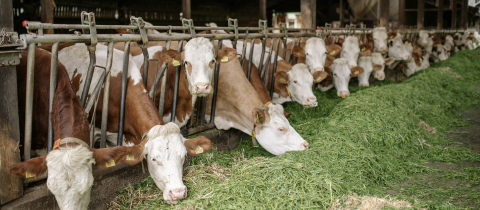Si vous voulez lire cet article en français, cliquez ici!
You may have stumbled upon scary headlines online about self-cleaning ovens, like “Why You Should (Almost) Never Use Your Oven’s Self-Cleaning Function”. There’s a lot of confusing information out there about the worth and potential risk of the self-cleaning function of an oven, so let’s try and clean up this mess.
The website HowStuffWorks reports that this functionality was introduced by GE Appliances in 1963 and is technically known as the “pyrolytic cleaning method” (from the Greek words pyro meaning “fire” and lysis meaning “loosening or dissolving”). This might imply that a massive fire is lit inside your oven to dissolve the crud but, actually, it’s heat that replaces elbow grease. Self-cleaning ovens can generate heat much above the 500ºF (260ºC) used for broiling: a self-cleaning cycle will go up to between 800 and 1,000ºF (427-538ºC). What happens to the food residue stuck to the inside of the oven is an irreversible chemical process. The high heat separates the complex molecules of the food, leaving behind a carbon-rich ash, which can be manually wiped clean at the end of the process.
If high-heat self-cleaning is a fairly common feature and if it works well, why are certain websites telling you not to use it? The problem is the fumes, which include carbon monoxide.
When carbon is linked to two oxygen atoms, it’s called carbon dioxide (CO2). We breathe it in the air and exhale it as a byproduct of our metabolism. But when carbon is linked to a single oxygen atom, it becomes carbon monoxide (CO) and its impact on our health is quite different. In sufficient quantities, it will prevent your blood from carrying oxygen, leading to flu-like symptoms and sometimes death.
Carbon monoxide is created and released by the self-cleaning function of ovens. The question is: how much? CO emissions represent a real hazard, meaning something that can potentially cause harm, but how much of a risk are they? A risk can be calculated based on a hazard and your exposure to it. A gorilla is a hazard but, if it’s behind bars at the zoo, it’s not much of a risk to your life.
To quantify the risk posed by CO emissions during the self-cleaning cycle, we must know how much CO is released. Unfortunately, the scientific literature is silent on this question. I could not find a single peer-reviewed source that had even attempted to measure how much CO is released by the self-cleaning function of an oven.
But carbon monoxide is not the only source of potential worries. Certain carbon-based chemicals, like polycyclic aromatic hydrocarbons (PAHs) and heterocyclic amines (HCAs), are created when meat is cooked at high temperatures (like barbecuing but, also, when using the self-cleaning function on ovens). These chemicals arise through the interactions between sugars, proteins, muscle creatine, and heat. While the complex chemical dance sugars and proteins do at high heat—the Maillard reaction—results in the distinctive taste of browned foods (like bread crusts and steaks), at even higher temperatures, it creates PAHs and HCAs which have been shown to cause cancer in laboratory animals. You may have heard that regularly charring your meat on the barbecue will increase your risk of developing cancer, and that’s because these types of chemicals are created and then ingested.
Unless you decide to eat the ash at the end of the self-cleaning cycle of your oven, you won’t be consuming PAHs and HCAs… but you will be inhaling them. Once again, we simply do not know if this type of exposure will significantly increase your cancer risk.
In the absence of hard data and in the presence of a potential risk, the best thing we can do is err on the side of caution. Many websites will suggest you open windows, ensure proper ventilation, and leave the room (and for some, the house) when running the self-cleaning function. If you have a bird, you may want to move them as far away from the oven as possible, because certain emitted fumes may trigger toxicosis, a disease affecting the bird’s respiratory system and leading to incoordination, convulsions, and death.
So if the room is well-ventilated and you and your pet take a walk, can anything else go wrong with a self-cleaning oven? There is anecdotal evidence that the high temperatures required for self-cleaning may prematurely burn out the thermal fuse, which keeps the oven from overheating. A burnt fuse means the oven can’t be used until the fuse can be replaced (at a cost). A common recommendation is to never use the self-cleaning function just before you have to cook for an important gathering (in case the fuse burns and you’re left scrambling to find a repair technician). Again, this evidence comes from repairmen who claim to have noticed a pattern. Is the self-cleaning function truly putting the thermal fuse at risk… or would those fuses have burnt out anyway? We simply don’t know.
You may be aware of a potentially safer alternative: self-clean with steam. The effectiveness of this method was tested by Consumer Reports and compared to high-heat pyrolytic (the traditional self-clean mode), and the latter was clearly the most effective method. Meanwhile, the steam option, in which you put a pan of distilled water at the bottom of the oven and run the low-heat “steam” function, was good for small messes but required a lot of manual scraping afterwards.
The self-cleaning function of an oven appears to be quite effective, but to which extent you put your health (and that of your oven) at risk remains a big question mark. My advice? If you’re going to use it, take a walk and don’t forget your parakeet.







